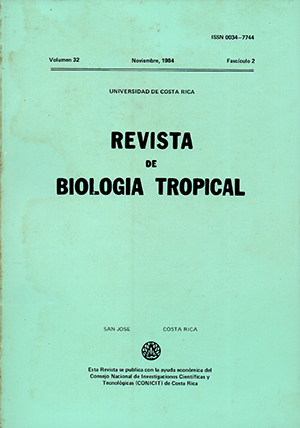Resumen
El estudio del ciclo de reproducción de Pteronotus parnellii mexicanus en un ambiente tropical semiseco de México, ha revelado que esta especie es monoestra estacional: la cópula ocurre en enero, la gestación transcurre desde febrero hasta fines de mayo y las crías nacen en la primera quincena de junio, cuando la temporada de lluvias ha comenzado y favorece la abundancia relativa local de insectos voladores, que son la fuente de alimento de este murciélago. Los embriones se encuentran implantados un 96,2% de las veces en el lado derecho del útero, que es bicorne, por lo que se reconoce una asimetría funcional que favorece al cuerno derecho del útero, siendo ambos ovarios funcionales. Los machos están activos todo el año, no obstante, sólo en diciembre, enero y febrero hay espermatozoides morfológicamente maduros en el epidídimo capaces de fecundar. La hipertrofia de sus glándulas accesorias es notable en diciembre y enero. La longitud de los testículos es variable, pero se requiere que midan por lo menos 3 mm durante la temporada de cópula para que presenten espermatozoides maduros en el epidídimo.Citas
Asdell, A. S. 1964. Patterns of Mammalian Reproduction. 2d ed. Ithaca. Cornell University Press. xi. +670 p.
Bateman, G. C. & I. A. Vaughan, 1974. Nightly activities of Mormoopid bats. J. Mamm., 55: 45-65.
Bourliere, F. 1973. The comparative ecology of rain forest mammals in Africa and Tropical America: some introductory remarks, p. 279-292. In B. T. Meggers, E.S. Ayensu, & W. D. Duckworth (eds.). Tropical forest ecosystems in Africa and South America. Smithsonian Institution Press.
Brenner, F. J. 1968. A three year study of two breeding colonies of the big brown bat, Eptesicus fuscus. J. Mamm., 49: 775-778.
Davis, W. B., M. D. Hassell, & M. J. Harvey. 1965. Maternity colonies of the bat Myotis l. lucifugus in Kentucky. Amer. Mid. Nat., 73: 161-165.
Fleming, T.H., E. T. Hooper, & D. E. Wilson, 1972. Three Central American bat communities: structure, reproductive cycles, and movement patterns. Ecology, 53: 555-569.
Goodwin, P. E. 1970. The ecology of Jamaican bats. J. Mamm., 51: 571-579.
Howell, D. J., & D. Burch. 1974. Food habits of some Costa Rican bats. Rev. 8io1. Trop., 21: 281-294.
Humphrey, S. R., 1975. Nursery roosts and community diversity of nearctic bats. J. Mamm., 56: 321-346.
Janzen, D. H., & T. W. Schoener. 1968. Differences in insect abundance and diversity between wetter and drier sites during a tropical dry season. Ecology, 49: 98-110.
Krutzsch, P. H. 1979. Male reproductive patterns in nonhibernating bats. J. Reprod. Fert., 56: 333-344.
Kunz, T. H. 1973. Population studies of the cave bat (Myotir velifer): reproduction, growth and development. Oceas. Pap. Mus. Nat. Hist., Univ. Kansas, 15, 1-43.
Kunz, T. H. 1974. Reproduction, growth and mortality of the vespertilionid bat, Eptesicus fuscus in Kansas. J. Mamm., 55: 1-13.
McNab. B. K. 1976. Seasonal fat reserves of hats in two tropical environments. Ecology, 57: 332-338.
Migula, P. 1969. Bioenergetics of pregnancy and lactation in European common vales. Acta Theriol., 14, 167-169.
Mills, R. S. G. W. Barrett, & M. P. Farrell, 1975. Population dynamics of the big brown bat (Eptesicus fuscus) in Southwestern Ohio. J. Mamm., 56, 591-604.
Novick, A. 1963. Orientation in neotropical bats II. Phyllostomatidae and Desmodontidae. J. Mamm., 44: 44-56.
Rzedowski, J., 1978. La vegetación de México. Limusa, México, 432 p.
Sampedro, J. A., O. Torres, & A. Valdés de la Osa. 1977. Observaciones ecológicas y etológicas en dos especies de murciélagos dominantes en las cuevas calientes de Cuba. Poeyana Inst. Zool. Acad. Cienc. Cuba, 160: 1-18.
Studier. E. H., V. L. Lysengen, & M. J. O'Farrell, 1973. Biology of Myotis thysanodes and M. lucifugus (Chiroptera: Vespertilionidae) II: Bioenergetics and pregnancy and lactation. Comp. Biochem. Physiol. A Comp. Physiol., 44: 467-471.
Villa, R. B. 1967. Los murciélagos de México: su importancia en la economía y la salubridad. Su clasificación sistemática. Inst. Biol., UNAM, xvi +491 p.
Wilson, D. E. 1973. Reproduction in neotropical bats. Period. Biol., 75: 215-217.
Wilson, D. E., & E. L. Tyson. 1971. Spermatogenesis in some neotropical species of Myotis. J. Mamm., 52, 420-426.
Wimsatt, W. A. 1979. Reproductive asymmetry and unilateral pregnancy in Chiroptera. J. Reprod. Fert., 56, 345-357.
Comentarios

Esta obra está bajo una licencia internacional Creative Commons Atribución 4.0.
Derechos de autor 1984 Revista de Biología Tropical


